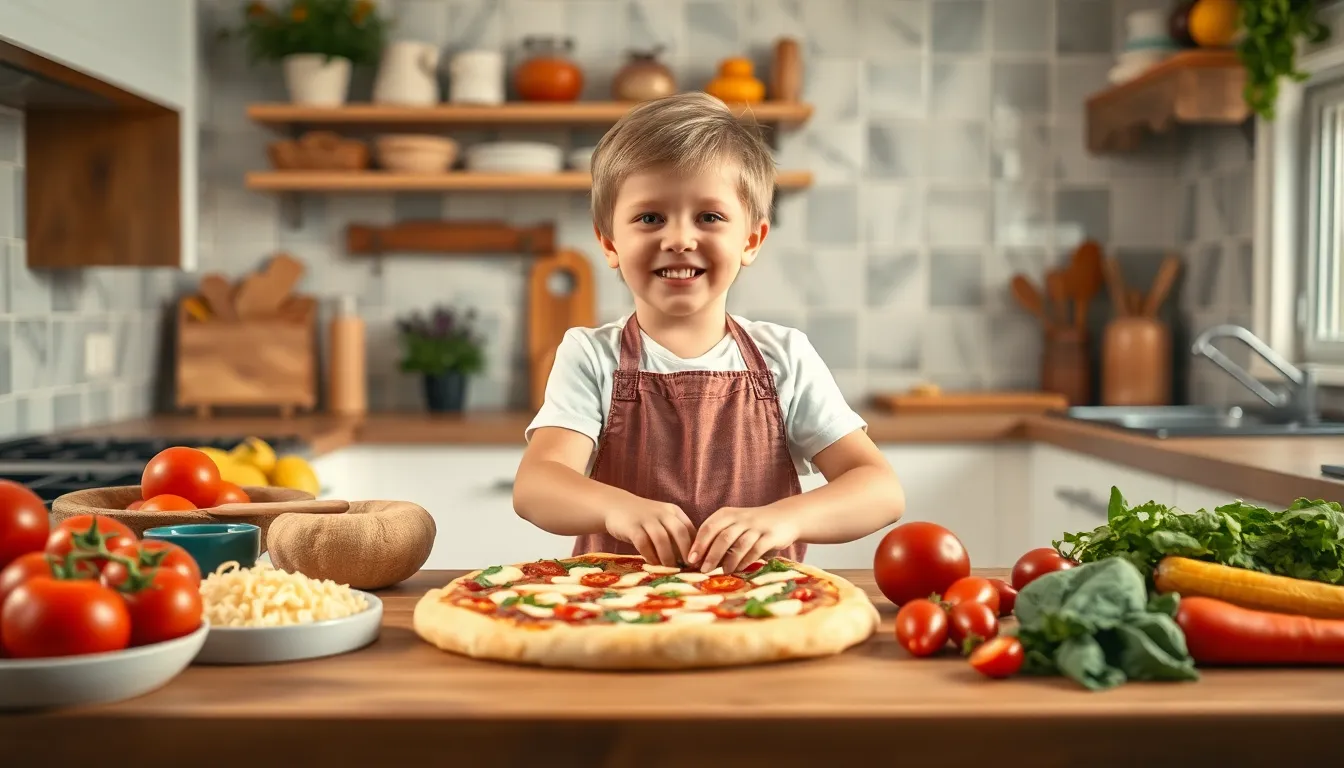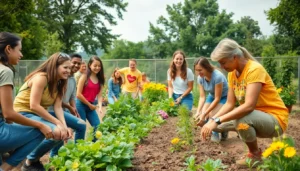Table of Contents
ToggleThere’s something magical about the aroma of fresh pizza wafting through the kitchen, especially when kids are involved. Imagine the joy on their faces as they roll out dough, sprinkle cheese, and unleash their creativity with toppings galore. Pizza making isn’t just a meal; it’s a delightful adventure that transforms a simple kitchen into a bustling pizzeria.
Benefits Of Pizza Making With Children
Making pizza with children offers numerous benefits, enhancing family connections while teaching valuable skills. Engaging in this fun activity fosters joy and learning.
Encourages Creativity
Pizza making promotes creativity in children. They explore various toppings, colors, and combinations that inspire their imagination. Expressing themselves through food builds confidence and lets them experiment. Each child designs a unique pizza, showcasing personal preferences. This creative outlet not only fuels enthusiasm but also stimulates critical thinking regarding flavor pairings and cooking techniques.
Teaches Cooking Skills
Cooking skills develop naturally during pizza making. Children learn essential tasks like measuring ingredients, kneading dough, and spreading sauce. Involvement improves their understanding of kitchen safety and hygiene. As they manipulate ingredients, hand-eye coordination and fine motor skills strengthen. Mastering basic cooking techniques sets a foundation for future culinary endeavors, encouraging independence and self-sufficiency in the kitchen.
Essential Ingredients For Homemade Pizza

Homemade pizza revolves around a few key ingredients. Understanding these basics ensures a delicious experience that both children and adults will enjoy.
Dough Options
Various dough options exist for homemade pizza. Traditional pizza dough consists of flour, yeast, water, salt, and olive oil. Whole wheat dough offers a healthier option, providing a nutty flavor that children may find appealing. For quick preparation, store-bought dough saves time and still delivers great taste. Gluten-free alternatives, such as cauliflower or almond flour base, cater to dietary needs while allowing everyone to participate. Each option allows children to learn about the texture and preparation methods involved in making dough.
Sauce Choices
Sauce choices can greatly influence the flavor of pizza. Classic tomato sauce provides a rich, tangy taste that complements various toppings. Pesto offers a fresh, aromatic alternative made from basil and garlic. Children might also enjoy experimenting with white sauce, which has a creamy texture and pairs well with vegetables. Barbecue sauce brings a sweet and smoky profile that’s perfect for unique pizzas. Encouraging kids to create their own sauces promotes creativity and builds ownership in the pizza-making process.
Toppings Variety
The toppings variety on homemade pizza opens endless possibilities. Common options include mozzarella cheese, pepperoni, and bell peppers. Unique choices like artichokes, olives, or goat cheese give children the chance to explore different flavors. Seasonal vegetables add freshness and bright colors that make the pizza visually appealing. Encouraging kids to select their favorite toppings fosters decision-making skills while ensuring each pizza reflects their individual tastes.
Step-By-Step Guide To Making Pizza With Children
Making pizza together creates lasting memories. Follow these simple steps to ensure a fun and engaging experience.
Preparing The Dough
Start with the right ingredients. Use flour, yeast, water, and salt for a classic dough. Mix the dry ingredients in a bowl before adding warm water gradually. Encourage children to knead the dough for about 5 to 10 minutes until it becomes smooth and elastic. Allow the dough to rise in a warm place for approximately one hour. During this time, discuss rising processes and the role of yeast. Once the dough has doubled in size, gently punch it down, allowing children to feel the texture. This hands-on experience excites them for the next steps.
Assembling The Pizza
After preparing the dough, roll it out on a floured surface. Use a rolling pin or hands, allowing kids to explore different shapes and sizes. Spread sauce, inviting suggestions about flavor combinations. Encourage creativity by letting them choose toppings like cheese, vegetables, and meats. Arrange toppings in fun patterns or shapes. Children can learn about portion control while assembling their own pizzas. Once completed, transfer the pizza onto a baking sheet or pizza stone, ensuring it’s ready for the oven.
Baking Tips and Tricks
Preheat the oven to 475°F for optimal baking. Ensure it’s hot enough to create a crispy crust. Use a baking stone if available, as it helps distribute the heat evenly. Place the pizza in the oven for about 10 to 12 minutes. Teach children to monitor the pizza closely until the cheese melts and the crust turns golden brown. Use oven mitts for safety when handling hot trays. Allow the pizza to cool for a few minutes before slicing. This cooling period enhances the flavors and makes it easier to cut.
Fun Pizza-Themed Activities
Engaging in pizza-themed activities creates memorable bonding experiences for families. These activities not only enhance creativity but also present opportunities for learning.
Pizza Crafts
Creating pizza crafts offers a hands-on way for children to express their artistic side. Kids can use materials like paper plates, colored construction paper, and markers to design their favorite pizzas. Scissors let them cut out various toppings like pepperoni or mushrooms, encouraging fine motor skills. Glue helps attach these toppings to the base, leaving room for imaginative combinations. Such projects can culminate in a mini art exhibition at home, showcasing each child’s unique pizza masterpiece. This fosters a sense of pride and accomplishment.
Educational Games
Incorporating educational games into pizza-making makes learning fun. Children can play matching games using flashcards featuring pizza ingredients, enhancing vocabulary and memory skills. Another engaging option includes a pizza-themed math game, where kids practice addition by counting toppings for each pizza. Using timers for these games teaches time management and quick thinking. Interactive storytelling around pizza can also spark creativity, with kids inventing tales about their creations. These games not only educate but also build confidence through enjoyable participation.
Pizza making with children transforms a simple meal into a memorable family adventure. It not only fosters creativity and confidence but also enhances essential cooking skills. Through this engaging process, kids learn about teamwork and decision-making while enjoying the freedom to explore their culinary preferences.
The joy of crafting their own pizzas leaves lasting impressions and strengthens family bonds. With countless ingredients and combinations to choose from, each pizza becomes a unique expression of individual tastes. Embracing this fun activity is a wonderful way for families to connect, learn, and create delicious memories together.






